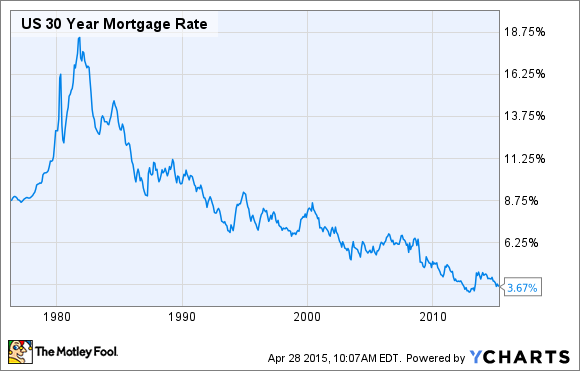
Source: Flickr user Mark Moz.
Before buying their first home, many people are determined to save enough money for a 20% down payment in order to avoid mortgage insurance, and to keep their payment low. However, the programs that offer lower down payments may be a better deal than you think. Here's how choosing to buy a home now could work out in your favor over the long run.
Down payment options
When it comes to buying a home, there are a few basic mortgage options, and the most common fall into these categories
- Conventional with no private mortgage insurance (PMI): Generally, these loans require decent credit, which is generally defined as a FICO score of 620 or more, and at least 20% down. This loan is likely to produce the lowest monthly payments.
- Conventional with PMI: Can be obtained with as little as 3% down for first-time homebuyers, or 5% down for everyone else. Good credit (standards depend on your down payment and other factors) is required, and the mortgage insurance can be dropped once the loan-to-value ratio is below 80%. It's also worth noting that the 3% down option is relatively new, and isn't offered by all lenders yet.
- FHA Mortgage: Require at least 3.5% down and can be obtained with lower credit scores (as low as 580 with the minimum down payment). FHA mortgage insurance is generally more expensive than PMI and consists of a 1.35% upfront premium and an ongoing 0.85% annual premium, based on the loan's balance.
- VA/USDA loans: Can be obtained with no down payment whatsoever for those who qualify. VA loans are available to eligible veterans, and USDA loans can be made on properties in rural areas if the borrowers meet income requirements.
Don't forget one important fact
When considering whether it's better to wait until you have enough saved for a 20% down payment or to take advantage of one of the low down payment options mentioned above, keep one thing in mind. Mortgage rates are about as low as they've ever been, and they are likely to increase at some point in the not-too-distant future.
Now, bear in mind that although it is not a one-to-one relationship, interest rates tend to increase along with the Federal Funds level, as you can see in the chart below. And most experts agree that the Federal Reserve is going to begin increasing rates sooner rather than later.
It may be a good idea to buy soon
So, if rates rise, in a few years, we could see 20% down mortgages that are actually more expensive than mortgages obtained with one of the low down payment loan options outlined above.
Consider an example of a $200,000 home purchased with various loan options and interest rate options (all 30-year fixed). I've excluded VA and USDA loans because they aren't available to all borrowers, but if you want to calculate your prospective payment under these programs, here is a useful VA loan calculator from US Bank, and some useful information from the USDA.
| Interest Rate: | 3.5% | 4% | 5% | 6% | 7% |
| Conventional, 20% down | $718 | $764 | $859 | $959 | $1,064 |
| Conventional, 10% down | $897 | $948 | $1,055 | $1,168 | $1,287 |
| Conventional, 5% down | $973 | $1,027 | $1,140 | $1,259 | $1,384 |
| Conventional, 3% down | $1,029 | $1,084 | $1,199 | $1,321 | $1,449 |
| FHA, 3.5% down | $1,009 | $1,063 | $1,178 | $1,299 | $1,426 |
Note: Payments include principal, interest, and mortgage insurance (if applicable). Taxes and hazard insurance are excluded.
As you can see, if interest rates rise a few points, the monthly payment on 20% loans could increase to the point where you would have been better off buying now and taking full advantage of the current low mortgage rates. Also, bear in mind that with all of the conventional loan options, you can request to drop the PMI once the loan reaches 80% LTV (loan-to-value), and it will be automatically dropped once the LTV reaches 78%.
It's not "if," but "when"
Nobody knows for sure when interest rates will finally begin to rise, or by how much and how quickly they will rise, but one thing is for sure: Interest rates won't stay this low forever, and they really can't get much lower than they are right now.
Of course, it's entirely possible rates will stay where they are for another year or two, or that rates won't spike enough to make mortgage payments rise to the magnitude the chart above reflects. However, if you want to eliminate the risk associated with rising interest rates, it may be a good idea to look into buying earlier rather than later.






